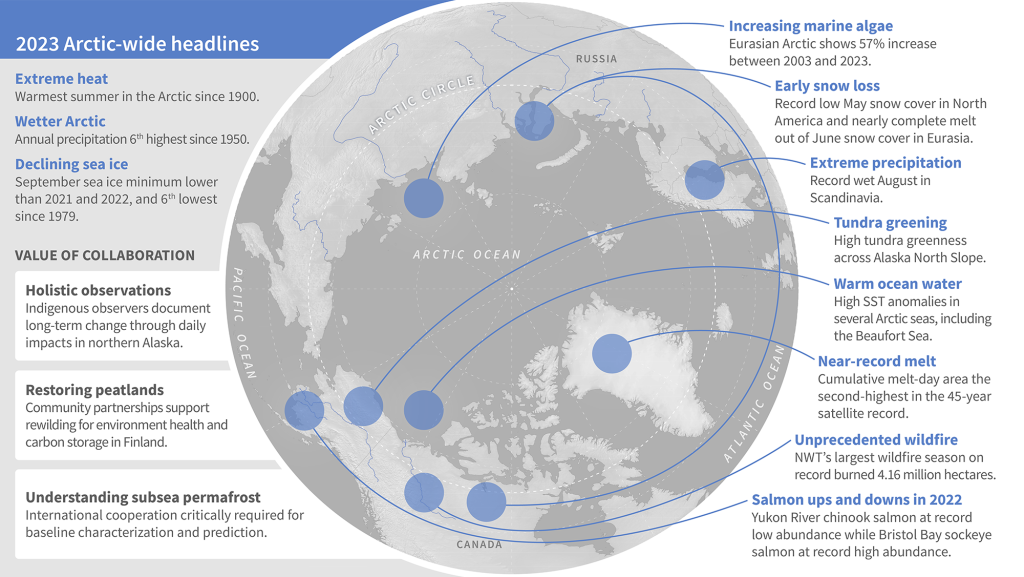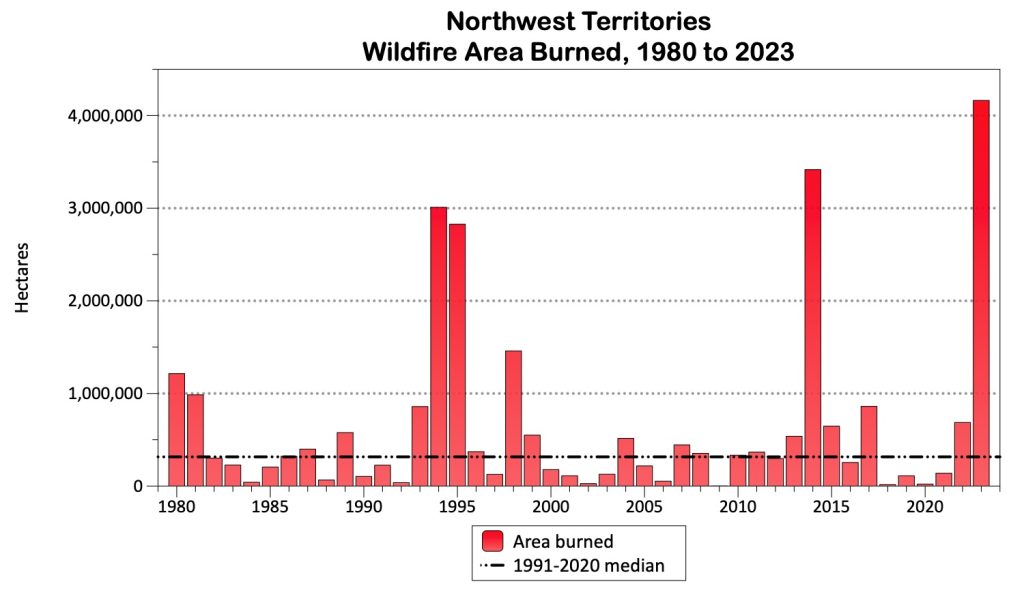R. L. Thoman1,2, T. A. Moon3, and M. L. Druckenmiller3
1Alaska Center for Climate Assessment and Policy, University of Alaska Fairbanks, Fairbanks, AK, USA
2International Arctic Research Center, University of Alaska Fairbanks, Fairbanks, AK, USA
3National Snow and Ice Data Center, Cooperative Institute for Research in Environmental Sciences, University of Colorado Boulder, Boulder, CO, USA
The Arctic continues to rapidly evolve, shaped by past and ongoing human activities that release greenhouse gases into the atmosphere and push the broader Earth system into uncharted territory. Now in its 18th edition, this year’s Arctic Report Card (ARC2023) provides an updated annual view into the state of the Arctic by checking in on key Vital Signs—eight defining elements of the Arctic’s climate and environmental system. ARC2023 also samples critical and emerging Arctic topics, bringing into focus diverse collections of observations that help to assess the trajectory and impacts of Arctic change. Figure 1 locates some of these events in the pan-Arctic perspective and Fig. 2 is provided as a convenient place name reference.



This year’s physical and biological Vital Sign observations are in line with trends reported in past Arctic Report Cards—warming sea surface and surface air temperatures, decreasing snow cover, diminishing sea ice, both in spatial extent and thickness, and continued mass loss from the Greenland Ice Sheet. Year-to-year variations, in addition to long-term trends, are significant and can be especially important at regional scales.
Extreme weather and climate events during the past year in the Arctic and elsewhere have brought unambiguous, climate change-supercharged impacts to people and ecosystems. Such events vary in scale across time and space. In the span of a few hours, individual storms may create hardships and damage that last for years. Longer-term extremes, such as drought or prolonged high temperatures, also have direct, distinct impacts, produce cascading effects in other parts of the environment, and may exacerbate (or mitigate) shorter time frame weather extremes.
Some high impact events are a clear signature of sustained climate change. For example, Canada experienced its worst national wildfire season on record. Multiple communities in the Northwest Territories were evacuated during August as a precaution, including more than 20,000 people from the capital city of Yellowknife (see Arctic Wildfire Sidebar). In August 2023 near Juneau, Alaska, a glacial lake on a tributary of the Mendenhall Glacier burst through its ice dam and caused unprecedented flooding and severe property damage on Mendenhall River, a direct result of dramatic glacial thinning over the past 20 years (see Wolkin et al. 2021 for additional examples).
Average surface air temperatures for the Arctic as a whole in the past year (October 2022-September 2023) ranked as the sixth warmest since 1900, and summer (July through September 2023) was the warmest on record. There were, however, important regional differences, including a colder-than-normal spring across Alaska that slowed snowpack and sea-ice melt, while parts of north-central Canada experienced the highest spring average temperatures on record. Prolonged warmth over Arctic lands can even impact summer sea ice extent and sea surface temperatures by warming waters in the major rivers draining the region, as noted this year near the ocean outlets of the Mackenzie River in North America and the Ob, Yenisei and Lena Rivers in Asia, draining areas that had significantly above-normal late spring and summer temperatures.
The presence or absence of sea ice and the timing of Arctic sea ice cover are major factors in modulating ecosystem and human activity. In spring 2023, the Arctic-wide sea ice volume was similar to spring 2022. Sea ice loss was slower than average at the start of the 2023 melt season but accelerated in July. By late August both the Northern Sea Route and Northwest Passage were open for non-ice hardened ship traffic. The September sea ice minimum extent of 4.23 million square kilometers (1.6 million square miles) was about 10 percent lower than the past two years, and overall the sixth lowest in the 45-year long satellite record. The 17 lowest minimum extents have all occurred in the 17 years since 2007.
Summer sea surface temperatures, tundra vegetation growth on land, and phytoplankton blooms or primary productivity in the sea are closely tied to the timing of sea ice loss and warm-season air temperatures. Spring and early summer loss of sea ice exposes the dark ocean surface and allows time for significant solar heating of the ocean. Linked to early sea ice loss, average sea surface temperatures for August 2023 were much higher than the 30-year average in the Barents, Kara, Laptev and Beaufort Seas. Anomalously cool August 2023 sea surface temperatures were observed in Baffin Bay, the Greenland Sea, and parts of the Chukchi Sea. The 2023 circumpolar average peak tundra greenness was the third highest in the 24-year MODIS satellite record, a slight decline from the previous year. Closely aligned with air temperatures and nearshore sea ice anomalies, peak vegetation greenness in 2023 was much higher than usual in the North American tundra, particularly in the Beaufort Sea region. In contrast, tundra greenness was relatively low in the Eurasian Arctic, particularly in northeastern Siberia. Both tundra greenness and primary productivity show multi-decade increasing trends but with significant regional and year-to-year variability.
The changing Arctic hydroclimate is documented through precipitation and snowfall (water equivalent) analyses. Precipitation in the past year was above normal in all seasons for the Arctic as a whole, but with important seasonal and regional variations. Unusually low precipitation and high temperatures produced severe drought and contributed to the record-breaking wildfire season in Canada’s Northwest Territory (see Arctic Wildfire Sidebar). Snowpack in early spring 2023 was above normal for both North America and Eurasia, but then rapid snow loss in much of the Arctic resulted in record low average snow water equivalent for the North American Arctic in May and near-record low snow cover for the Eurasian Arctic in June.
Precipitation patterns also influence the Greenland Ice Sheet. Above-average snowfall over parts of the Greenland Ice Sheet between autumn 2022 and spring 2023 contributed to a relatively low (for the 21st century) total mass loss from the Greenland Ice Sheet in spite of extensive late June to September ice melt. So, while the Greenland Ice Sheet lost mass in the past year, as it has every year since 1998, the loss for September 2022 to August 2023 was much lower than the 22-year average and similar to 2020-21. However, the cumulative melt-day area during summer 2023 was the second-highest in the 45-year satellite observational record.
Since time immemorial the Arctic has been home to diverse peoples, and through hundreds of generations they have honed the skills needed to thrive in this environment. In recent years, Western science and societies are more strongly and equitably recognizing the value of the lived experiences and cultural expertises of Arctic Indigenous peoples, not just as a source of information but as experts. ARC2023 features a Frostbite on the yearslong work of the Alaska Arctic Observatory and Knowledge Hub, a collaborative effort wherein community experts in northern Alaska communities, including Indigenous Knowledge holders, share their expertise and observations, which are fundamentally important for tracking the scale and implications of Arctic change. The value of Indigenous Knowledge to address contemporary environmental problems is also highlighted in an essay on the restoration of peatlands in northern and eastern Finland.
The Arctic Report Card also aims to shed light on some of the least understood features of the Arctic environment. In ARC2023, we address the divergent trends of salmon in western Alaska, where Chinook and chum salmon returns are collapsing on the Yukon and Kuskokwim Rivers, while at the same time sockeye salmon in Bristol Bay are at near record high numbers. Both extremes are having severe economic and cultural impacts. Changing environmental conditions clearly are playing a role yet additional work incorporating both Indigenous Knowledge and Western science is needed to understand what is driving these observed trends. We also examine the state of observations of subsea permafrost. Subsea permafrost today exists in Arctic regions that were aerially exposed during the late Pleistocene but were subsequently submerged by rising sea levels. Detailed research exists for only small portions of the Kara and Beaufort Seas, but by far the largest area of subsea permafrost underlies the modern Laptev and East Siberian Seas. There is a lack of observations and research in these areas, significantly inhibiting our understanding of how and when the rapidly warming Arctic will affect the more than 2 million km2 of subsea permafrost. This scientific gap highlights the urgent need for international cooperation to better understand this facet of the Arctic system.
ARC2023 includes 12 essays providing multiple perspectives on the rapidly transitioning Arctic. Long-term trends are reinforced by another year of observations, while the importance of year-to-year variability and regional differences across the Arctic are apparent. Extreme weather and climate events and their impacts to society and ecosystems are stark reminders that transition is not just about multi-decadal trends but about day-to-day living in and around the Arctic. The Arctic remains a varied, expansive, and expensive region to monitor. To understand and adapt to this transition, local to international partnerships, including with Arctic Peoples and Indigenous communities, are vital for collecting and using diverse observations and knowledge, as well as for identifying resilient actions to long-term climate impacts and abrupt disturbances.
Arctic Wildfire 2023
During late summer 2023, northern Canada experienced unprecedented and destructive wildfire. Because topics for the annual Arctic Report Card (ARC) are selected and finalized by early summer, the report was unable to include a full essay on this extraordinary wildfire season and associated impacts. This sidebar, however, provides a brief report on the Arctic summer wildfire season.
Based on government reporting, as of late October 2023, wildfire burned 4.61 million hectares (11.39 million acres) in high-latitude North America (Alaska, USA and Yukon Territory and Northwest Territories, Canada). More than 90 percent of the area burned was in the Northwest Territories, where about 300 separate fires burned 4.16 million hectares (10.28 million acres), the largest area burned in 44 years of record (Northwest Territories Department of Environment and Climate Change 2023, see Fig. SB1).


A dozen communities both north and south of Great Slave Lake were evacuated due to the threat posed by wildfire. At some time during the summer, more than two-thirds of the Northwest Territories’s 46,000 residents were displaced, in many cases for weeks at a time, with significant economic impacts from lost income, disrupted traditional activities, and infrastructure lost to the fires (Thompson 2023). The community of Enterprise, NWT was largely destroyed by a fast moving fire during 13-14 August 2023 (CBC News 2023). And like much of Canada, there was widespread prolonged poor air quality from dense smoke.
In contrast to the Northwest Territories, the Yukon Territory’s area burned was about 328,000 hectares (810,000 acres), which is slightly above the previous 30-year median. In Alaska, wildfires burned 119,500 hectares (295,000 acres), less than half of the 30-year median (Alaska Interagency Coordination Center 2023). Although not complete, preliminary remote sensing-derived estimates of Siberian (Sakha Republic) wildfire in 2023 indicates that the area burned was slightly higher than 2022, but much lower than the summers of 2018 to 2021 (A. Soja and E. Gargulinski, NASA Langley Research Center, 14 September 2022, personal communication).
Wildfire in the Arctic and sub-Arctic boreal forest is a natural part of the ecosystem, but the extent and intensity of fires has likely changed over time, in part due to changing human activity and recent variations in wildfire management practices. High latitude wildfire poses threats to human life, property and activities, including traditional food gathering. In recent years, extreme wildfire activity relative to the late 20th and early 21st centuries’ averages has occurred in the North American or Eurasian sub-Arctic in most summers (York et al. 2020). Separate essays on high-latitude wildfires were published in the 2017 and 2020 ARC, and we expect to report more fully on recent wildfires in a future ARC.
References
Wolkin, G. J., and Coauthors, 2021: Glacier and permafrost hazards. Arctic Report Card 2021, T. A. Moon, M. L. Druckenmiller, and R. L. Thoman, Eds., https://doi.org/10.25923/v40r-0956.
Sidebar Wildfire References
Alaska Interagency Coordination Center, 2023: https://fire.ak.blm.gov/, accessed 31 October 2023.
CBC News, 2023: “Enterprise, N.W.T., ’90 per cent gone’ after wildfire ravages community” (15 August 2023). https://www.cbc.ca/news/canada/north/enterprise-damage-wildfire-1.6936652, accessed 15 September 2023.
Northwest Territories Department of Environment and Climate Change, 2023: https://www.gov.nt.ca/ecc/en/services/wildfire-update, accessed 31 October 2023.
Thompson, Shane, Northwest Territories Minister of Environment and Natural Resources, Ministers’ Statements and Speeches, 2023: Remarks on 28 September 2023, https://www.gov.nt.ca/en/newsroom/shane-thompson-historic-2023-wildfire-season, accessed 29 October 2023.
York, A., U. S. Bhatt, E. Gargulinski, Z. Grabinski, P. Jain, A. Soja, R. L. Thoman, and R. Ziel, 2020: Wildland fire in high northern latitudes. Arctic Report Card 2020, R. L. Thoman, J. Richter-Menge, and M. L. Druckenmiller, Eds., https://doi.org/10.25923/2gef-3964.
Yukon Wildfire Services, 2023: https://wildfires.service.yukon.ca/, accessed 31 October 2023.
March 28, 2024
